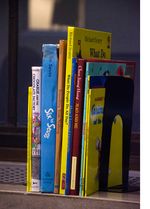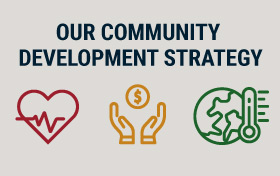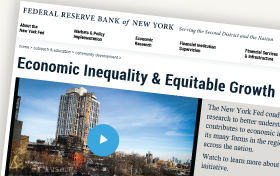Amy Farber
Would it ever occur to anyone that Charlie and the Chocolate Factory (Roald Dahl, 1964) teaches economic lessons about “incentives, poverty, scarcity, producers, consumers, and competition”? Or that The Lorax (Dr. Seuss, 1971) covers “natural resources, choices, and scarcity”? Or that Curious George Goes to a Chocolate Factory (Margret and H. A. Rey, 1998) is an examination of “producers, capital resources, and goods”?

So the Rutgers University Project on Economics and Children informs us in reviews of economic lessons embedded in children’s literature. The project’s mission is to provide “teachers, parents, and volunteers with ideas for using children’s literature to introduce economics to children.” On the Top Five Books by Concepts page, there are twenty-three economic subject categories from “Allocation and Distribution” to “Wants/Needs.” Each category contains the top choices illustrating those concepts, but a longer, comprehensive list containing hundreds more titles with their concept categories is available.
The topic of economics within children’s books was taken up by Motoko Rich in an August 20, 2011, New York Times article, Fairies, Witches and Supply and Demand (as well as in a follow-up piece two days later), in which she asks economists about themes they’ve noticed in their reading. She finds that some concept portrayals don’t sit right with them:
Sometimes, economists think that children’s books get things wrong. Dr. Seuss’s “The Lorax,” about the destruction of a forest by a greedy industrialist, “assumes that there is no economic system in place,” [Indiana State University’s John] Conant said. In a modern capitalist economy, he said, the trees “would get very valuable as they got scarce, and the person with the property rights would harvest them at an economically reasonable rate.”
By and large, the economic lessons in children’s books lean left of center. “I think the writers are not particularly sympathetic to or don’t understand how a market works,” said Gary S. Becker, the Nobel laureate who teaches economics at the University of Chicago. “It’s not easy to convey that to a child. It’s not always easy to convey it to grown-ups.”
A CNNMoney broadcast introduces Yana Rodgers, who runs the Rutgers Project, and her family. The video briefly mentions the project, the website, and children’s literature, but spends more time discussing the details of family life and parenting when both parents happen to be economists. Egad.
Disclaimer
The views expressed in this post are those of the author and do not necessarily reflect the position of the Federal Reserve Bank of New York or the Federal Reserve System. Any errors or omissions are the responsibility of the author.
Amy Farber is a research librarian in the Federal Reserve
Bank of New York’s Research and Statistics Group.














 RSS Feed
RSS Feed Follow Liberty Street Economics
Follow Liberty Street Economics
“the trees “would get very valuable as they got scarce, and the person with the property rights would harvest them at an economically reasonable rate.”” … ever look at satellite images of Central America ? Theory sounds very logical but humans aren’t especially.
The Federal Reserve Bank of St. Louis has more than 40 lesson plans that include interactive whiteboard activities (SMART and/or Promethean) for teaching economics using children’s books. Check out these and other classroom resources for teaching economics and personal finance in the K-12 classroom at: http://www.stlouisfed.org/education_resources/